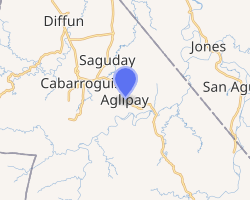Aglipay, Quirino
Aglipay, officially the Municipality of Aglipay, is a 3rd class municipality in the province of Quirino, Philippines. According to the 2015 census, it has a population of 27,787 people.[3]
Aglipay | |
|---|---|
| Municipality of Aglipay | |
 Seal | |
 Map of Quirino with Aglipay highlighted | |
OpenStreetMap 
| |
.svg.png) Aglipay Location within the Philippines | |
| Coordinates: 16°29′20″N 121°35′14″E | |
| Country | |
| Region | Cagayan Valley (Region II) |
| Province | Quirino |
| District | Lone District |
| Named for | Gregorio Aglipay |
| Barangays | 25 (see Barangays) |
| Government | |
| • Type | Sangguniang Bayan |
| • Mayor | Jerry T. Agsalda |
| • Vice Mayor | Warlita G. Alberto |
| • Congressman | Junie E. Cua |
| • Electorate | 18,689 voters (2019) |
| Area | |
| • Total | 161.70 km2 (62.43 sq mi) |
| Elevation | 161.0 m (528.2 ft) |
| Population (2015 census)[3] | |
| • Total | 27,787 |
| • Density | 170/km2 (450/sq mi) |
| • Households | 6,540 |
| Economy | |
| • Income class | 3rd municipal income class |
| • Poverty incidence | 14.07% (2015)[4] |
| • Revenue (₱) | 99,358,444.55 (2016) |
| Time zone | UTC+8 (PST) |
| ZIP code | 3403 |
| PSGC | |
| IDD : area code | +63 (0)78 |
| Climate type | tropical rainforest climate |
| Native languages | Ilocano Ilongot Arta Tagalog |
| Website | www |
Barangays
Aglipay is politically subdivided into 25 barangays.
- Dagupan
- Dumabel
- Dungo (Osmeña)
- Guinalbin
- Ligaya
- Palacian
- Pinaripad Sur
- Progreso (Poblacion)
- Ramos
- Rang-ayan
- San Antonio
- San Francisco
- San Leonardo
- San Ramon
- Victoria
- Villa Pagaduan
- Villa Santiago
- Alicia
- Cabugao
- Diodol
- Nagabgaban
- Pinaripad Norte
- San Benigno
- San Manuel
- Villa Ventura
Demographics
| Population census of Aglipay | ||
|---|---|---|
| Year | Pop. | ±% p.a. |
| 1960 | 3,976 | — |
| 1970 | 7,854 | +7.04% |
| 1975 | 9,775 | +4.49% |
| 1980 | 12,335 | +4.76% |
| 1990 | 16,427 | +2.91% |
| 1995 | 20,205 | +3.95% |
| 2000 | 21,774 | +1.62% |
| 2007 | 25,069 | +1.96% |
| 2010 | 26,187 | +1.60% |
| 2015 | 27,787 | +1.14% |
| Source: Philippine Statistics Authority[3][5][6][7] | ||
References
- "Municipality". Quezon City, Philippines: Department of the Interior and Local Government. Retrieved 31 May 2013.
- "Province: Quirino". PSGC Interactive. Quezon City, Philippines: Philippine Statistics Authority. Retrieved 12 November 2016.
- Census of Population (2015). "Region II (Cagayan Valley)". Total Population by Province, City, Municipality and Barangay. PSA. Retrieved 20 June 2016.
- "PSA releases the 2015 Municipal and City Level Poverty Estimates". Quezon City, Philippines. Retrieved 12 October 2019.
- Census of Population and Housing (2010). "Region II (Cagayan Valley)". Total Population by Province, City, Municipality and Barangay. NSO. Retrieved 29 June 2016.
- Censuses of Population (1903–2007). "Region II (Cagayan Valley)". Table 1. Population Enumerated in Various Censuses by Province/Highly Urbanized City: 1903 to 2007. NSO.
- "Province of Quirino". Municipality Population Data. Local Water Utilities Administration Research Division. Retrieved 17 December 2016.
External links
- Aglipay Profile at PhilAtlas.com
- QuirinoProvince.org
- Philippine Standard Geographic Code
- Philippine Census Information
- Local Governance Performance Management System
This article is issued from Wikipedia. The text is licensed under Creative Commons - Attribution - Sharealike. Additional terms may apply for the media files.